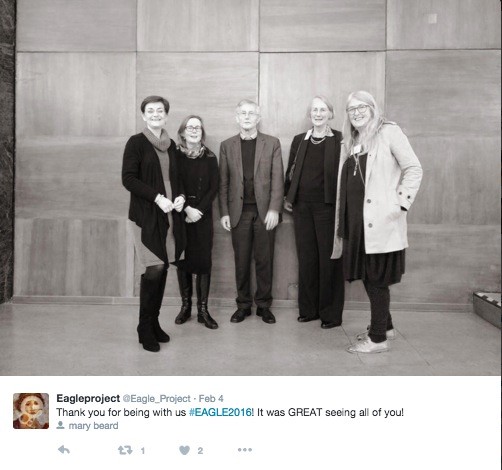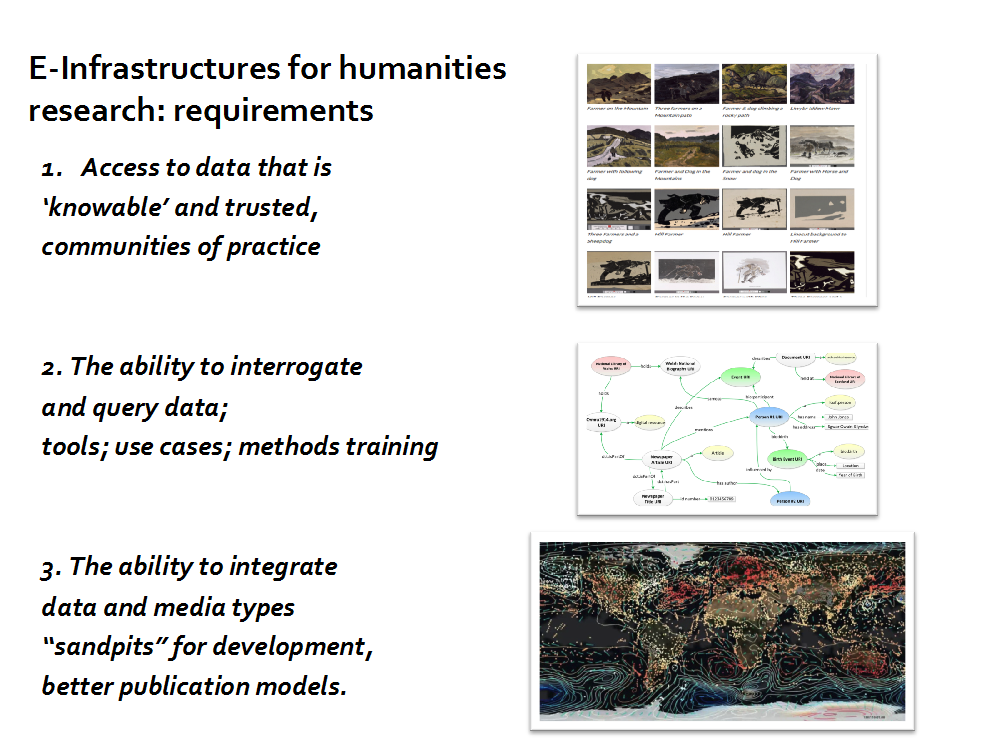Europeana Research at the EAGLE Conference, Rome, 27-29 January 2016
This article is by Lorna Hughes, Professor of Digital Humanities, Humanities Advanced Technology and Information Institute, University of Glasgow
@lornamhughes

I was very pleased to recently receive an invitation to present a keynote on behalf of Europeana Research at the EAGLE Conference at Sapienza, University of Rome. EAGLE is the Europeana network of Ancient Greek and Latin Epigraphy, and the conference brought together many members of the Network who are working with digital content and developing tools and services for the wider community. In addition to presentations by members of the Network, the conference included keynotes by leading figures from the epigraphic research community: Mary Beard, Cambridge University; Charlotte Roueché, King’s College London; and Werner Eck, University of Cologne. The whole event was steered flawlessly by the Silvia Orlandi, the Eagle Chair, and Raffaella Santucci, the conference organizer.
EAGLE provides a single, user-friendly portal to the vast majority of the surviving inscriptions of the Greco-Roman World, as well as explanatory information and translations for the most important: a massive resource for researchers as well as the public. As part of Europeana, the EAGLE dataset includes over 1.5 million items, currently held across 25 EU countries as well as the east and south Mediterranean. EAGLE has supported the development of services such as a mobile application, allowing tourists to understand the inscriptions they find in situ by taking snapshots with smartphones, and a storytelling application that will allow teachers and experts to assemble epigraphy-based narratives. A multilingual wiki supports interaction with epigraphic images and texts. The metadata that enriches the digital images (photographs, drawings, scanned notes, manuscripts and archive material, ancient books out of copyright) includes semantic enrichment through geographic information, provided in close collaboration with the Pleiades project of a digital Atlas of the ancient world, operated by the New York University’s Institute for the Study of the Ancient World.
Many aspects of the research covered by the Network were covered in the keynote presentations. Charlotte Roueché discussed the many years of work she has put into digital resources like the Inscriptions of Aphrodisias Project, highlighting the concerns around sustainability of, and continuing accessibility to, scholarship that relies on digital sources, tools and methods. Werner Eck discussed the potential of digital approaches for creating new understanding of the Roman World.
Mary Beard’s presentation reminded us of the importance of inscriptions as primary historical sources, bringing to light hidden histories about the people of the ancient world, their laws, customs, as well as their personal relationships, likes and dislikes, even their grievances and unhappy marriages.
Given the emphasis on use and re-use of the rich collection of primary sources, gathered by the extensive community of researchers that have been able to work together through the Network, and using the Europeana platform, my presentation emphasised the needs of scholars in the digital realm: how we can carry out humanities research in what Roy Rosenzweig called the digital ‘culture of abundance’. I discussed how digital collections can be used for research in the humanities; and how a better understanding of the place of digital collections in the research life-cycle can provide a critical framework for future development of digital collections by Galleries, Libraries, Archives and Museums (the so-called GLAM) sector. This perspective provides an evidence base that can be used in the development of the research infrastructures that share this content, and make it openly accessible for use and re-use. In this context, I’ve been working with Europeana as Chair of Europeana Research Advisory Board, and my presentation was an opportunity to discuss how Europeana is developing a programme of engagement with the research community to make its content more accessible for research, and to develop its collections, as well as enable the humanities to exploit the ‘digital turn’, and use digital tools, content, and methods for research. The greatest opportunities to draw of the expertise in the digital humanities community to add value to digital cultural heritage lie in three key areas: the provision of trusted, open content that is ‘pre-knowable’ from the perspective of quality control; the ability to liberate content from its mode of production and dissemination for reinterpretation and analysis by open tools; and the use of multimedia content in an integrated way, liberating data from silos of content type.

Figure 1: Research requirements in a ‘digital culture of abundance’
Europeana Research is currently developing approaches to address these needs, bringing together the metadata, content, tools and services that Europeana portal with Digital Humanities research and the communities of practice have evolved around specific genres of content, and specialist tools and methods.
There’s plenty in Europeana to enable digging further into these issues: helping researchers to select content from what’s available; supporting the creative use and re-use of content, and working with multimedia content in different disciplines and formats. Europeana has identified several ways it can do more to focus on researchers. For example, building focussed aggregations of content, particularly full-text, and exploring how the content can be re-used by the research community, based on some successful examples with Europeana Newspapers. This will mean highlighting collections in the Europeana dataset of specific interest to researchers. Similarly, exposing Europeana’s aggregations of text and metadata to allow research teams and infrastructures to build specific tools and services to fulfill particular research tasks, like looking for links between types of data, or doing visualisations of data to test theories and ideas.
Therefore, development of Europeana Research will be a priority over the next couple of years: as a forum for exploring these issues, it will be an important mechanism for connecting digital heritage with the research community. It has established an Advisory Board to direct a series of funded activities to enhance the use of Europeana for research, and to better document some of the innovation that can be achieved in re-using digital cultural heritage content.
This work will have five areas of focus, be carried out by my colleagues in the Humanities Advanced Technology and Information Institute, at the University of Glasgow, at the Digital Curation Unit in Greece, and at the Europeana Foundation:
1. Developing a grants programme: The grants programme will offer funds to researchers work with digitised content from the cultural sector: exploring how content can be re-used by the research community.
2. Expanding Collections for Re-Use on Europeana Research: The Europeana Research platform highlights various featured collections available for re-use. These collections will be expanded and have extra descriptive metadata.
3. Develop enhanced ways to describe the use of Europeana content with DH tools and methods, through user engagement and dialogue with groups working in specific disciplinary areas.
4. Continuing exploration of use case of Europeana Content: Undertaking use cases exploration and related focus groups on use of Europeana content.
5. Developing a Research Advisory Board, with representatives across the Arts and Humanities
We hope that this programme of work will have wider benefit for the digital humanities research community. The opportunity to conduct this work, and engage with researchers directly and develop a better understanding of how they can work with digital content and metadata, and how they can develop a better awareness and understanding of available tools for analyzing data through the Europeana platform, will provide an important layer of evidence that will also help shape the development of other research infrastructures in the humanities.
Europeana Research is an important opportunity for a praxis-based critical engagement that is the key to understanding the ways that the digital is affecting knowledge production: drawing us into new collaborations, leading us to encounter new methods for engaging with content, and assisting in developing new insights into our cultural heritage.
EAGLE is a best-practice network financed by the European Commission, under the ICT policy of its Competitiveness and Innovation Programme (CIP – ICT PSP). It has been funded from 2011 and will conclude in April 2016: in many respects, the conference was ‘the end of the beginning’: developing the content and establishing the community. The focus will now be on use and re-use of the EAGLE dataset for new and innovative purposes, by epigraphers and other disciplines interested in the Ancient World. We very much hope that Europeana Research will be able to collaborate with these communities of practice.
A full version of this presentation will be included in the proceedings of the EAGLE conference, published by Sapienza, University of Rome.
More information about EAGLE
EAGLE and Wikimedia Italia
EAGLE’s key collaboration is the one established with Wikimedia Italia. EAGLE features the development of the first Wikibase platform outside of Wikidata. The extension installed in the EAGLE Mediawiki allows for major corpora of online inscriptions to be imported with their corresponding translations. It also allows for connections with Wikimedia Commons (see also http://meta.wikimedia.org/wiki/Europeana/Projects#EAGLE).
EAGLE Featured Stories
EAGLE partners are writing short stories related to inscriptions (highlights) in their respective collections, which are being used for dissemination and user

